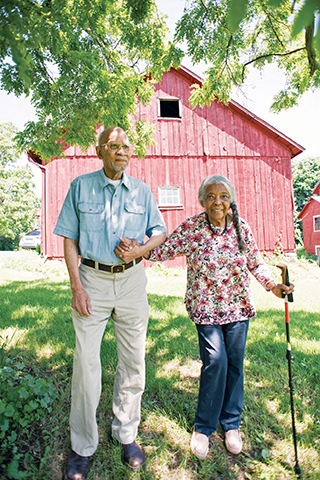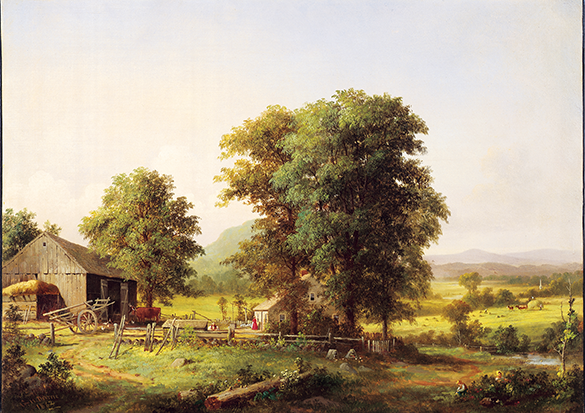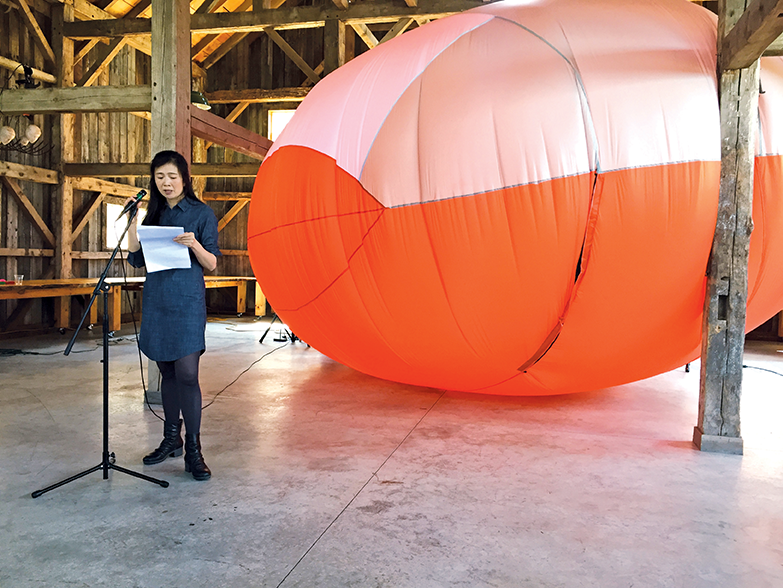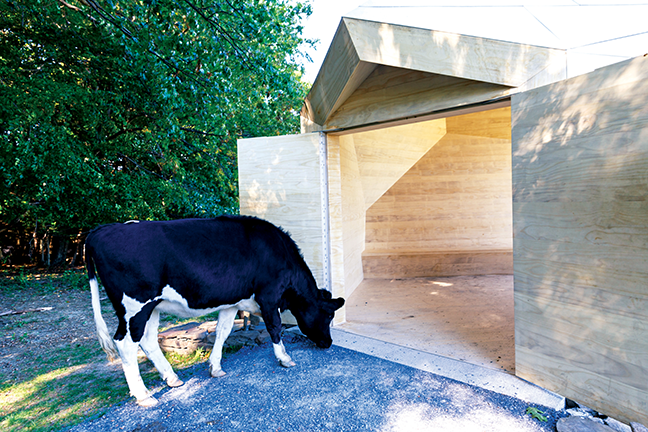Growing Culture
Dr. Jackson and Mrs. Lydia Clemmons, owners of the Clemmons Family Farm in
Charlotte, VT. Photo: Caleb Kenna.
“When tillage begins, other arts follow,” said Daniel Webster in a speech at the Boston State House in 1840. His words were about the importance of agriculture, yet he could have been referring to the Griswold family in Old Lyme, CT, who the following year, in 1841, purchased the farmland that later became the Florence Griswold Museum.
The Griswold Museum is just one in a line, continuing today, of New England cultural
institutions that started out as farms. It began with the first European settlers who came to tame the wild open landscapes, creating what cultural geographers call a “sense of place.”
This New England identity with the land has drawn artists and farmers alike in a symbiotic relationship that has evolved over time in response to shifting economic, cultural and environmental pressures.
Art and the New England Farm, an exhibition of paintings, drawings and photographs at the Florence Griswold Museum provides a perfect framework to begin thinking about the history and evolution of farming and the farm’s place in the art world.
First, consider the farm as muse. Museum curator Amy Kurtz Lansing starts the exhibition in the early 19th century with an emphasis on the paintings of George Henry Durrie, a Connecticut artist whose idyllic scenes of rural life became popularized as Currier and Ives lithographs. In contrast, Walker Evans, best known for his work with the Farm Security Administration in the 1930s, took advantage of opportunities to document reality through the advancement of photo technology. In his groundbreaking book Let Us Now Praise Famous Men, Evans’s searing images portray the heartbreaking rural poverty of three farm families devastated by the Great Depression.
George Henry Durrie, Summer Landscape, 1862. Oil on canvas, 22 x 30″. Florence Griswold Museum, Gift of The Hartford Steam Boiler Inspection and Insurance Company.
The Griswold exhibition takes us from farm life in the past to today in the work of artist/photographer Judy Friday of Lyme, CT. Material from her book, A Year at Tiffany Farms, occupies several galleries and documents a seasonal round with photographs, history and operational detail about one of the few remaining dairy farms in Connecticut.
Art and the New England Farm is a timely exhibition. The rebirth of small niche farms to serve the growing appetite for organic produce, the recognition of localvore and a surge in farm-to-table menus has driven a desire to rediscover the farm. The Griswold’s history illustrates this ongoing trend to repurpose farmland.
Western New England, from the Berkshires through Vermont, is a hotbed of family farms that have been transformed into art centers. The Clark Art Institute, for example, occupies 140 acres of former farmland, known as Stone Hill, in Williamstown, MA. Although the husband and wife founders were never farmers, art was their passion, and by the mid-20th century, they had amassed a major collection of European and American art. With family ties to Williams College they decided to build a museum that was within walking distance from the college to their collection. In 1955, the museum and its research component opened to the public and in 2014, they added the spectacular 42,600-square-foot Clark Center. Designed by Pritzker Prize–winning architect Tadao Ando, the new building pays homage to the spectacular natural setting yet seems to negate any signs of farming. Sensing Place, a 2016 exhibition, revisited the history of the farm and the surrounding landscape. Reflections from farmer Jim Galusha, whose family has been working this land since the 1900s, were included in the exhibition.
Writer in residence, Linda Rui Feng reads her work beside inflatable sculpture by multidisciplinary artist in residence, Tamar Ettun in the Marble House Project event barn at
Art Seed on May 5th, 2018.
The Marble House Project, a working farm in the old quarry town of Dorset, VT, is also a multidisciplinary artist residency. Founded in 2014, the farm connection is the beating heart of its existence, woven throughout its mission and specifically referenced in its website tagline “Art Made—Farm Grown—Community Engaged.” The 140 artists hosted so far at Marble House brought their work-in-progress in dance, sound art, painting, sculpture, mixed-media, new-media, music composition, creative writing, film, photography, architecture and journalism. The artists, in turn, are expected to participate in the Marble House approach to sustainable living and to take any new practices learned back to their own communities and families. Energy use, conservation and saving the planet for our children’s future is their mission. These themes exert a strong influence on the residents’ work, and artists are the perfect vehicle to serve the mission because of the historical role they play in society as changemakers. The National Endowment for the Arts, through an Art Works grant, recently funded the Marble House’s ART Seed—a series of events for residency artists to present their work to the community to both inform and influence public understanding of our collective impact on the environment.
A cow interacts with the sculpture, Thomas Schütte Crystal, during Schütte Family Day at the Clark Art Institute. Photo: Tucker Bair/Clark Art Institute.
According to the 2012 agricultural census, the Clemmons Family Farm is one of only 19 African American–owned farms of the nearly 7,000 farms in Vermont. Lydia Clemmons and her husband, Dr. Jackson Clemmons, have owned the 148-acre farm in Charlotte, VT, since 1962. The couple restored the farm while working it, raised a large family, maintained an active professional life and frequently traveled to Africa, collecting art along the way. Their unique collection inspired Lydia to open Authentica African Art Imports in the historic blacksmith’s shop that her husband had restored on their farm. It was the first African art mail-order import business in the United States. Recognizing the unique contribution her parents made to farming, local history and the existence of African culture in the “whitest state in the union,” the family’s eldest daughter, also named Lydia, has helped to transform the farm into a nonprofit cultural center. In 2018 their first programming initiative, A Sense of Place, was awarded a $350,000 grant from ArtPlace’s National Creative Placemaking Fund. Now this historic venue offers music, dance, art, theater performances and culinary arts events to remind us of the importance of African culture.
Other long-standing cultural institutions were founded and flourished in the soil of New England farms. In 1790, Jacob’s Pillow was a 220-acre mountaintop farm in Becket, MA. Ted Shawn, the modern dance pioneer, bought the farm in 1930 as a retreat where he cultivated a new masculine identity for men to pursue a career in dance. Today the rustic ambiance of “the farm,” as Shawn called it, can still be felt and seen in the extensive facilities that include several theaters, multiple dance studios to serve the students of the School at Jacob’s Pillow, several cafés, a visitor welcome center, a great lawn and an amphitheater. Each summer the famed Jacob’s Pillow Dance Festival presents a full spectrum of dance, from classical ballet to virtuosic tap, performed by internationally acclaimed dancers. The Inside/Out Series is a wildly popular free event where audiences have the opportunity to experience other cultures through the art of dance. Ted Shawn died at the age of 81 in 1972, yet his vision for that mountaintop farm was cemented in 2000 when Jacob’s Pillow was listed on the National Register of Historic Places.
Farm to Ballet performs at the Shelburne Farm’s Breeding Barn. Photo: Brandon Parrish.
The Farm to Ballet Project is a more recent Vermont-grown dance organization initiated by Chatch Pregger, a professional dancer and dance instructor who found inspiration in the farm-to-table movement. Its mission has similarities to the Marble House Project in that it is tied to an environmental cause. In this case, dance is the vehicle to promote a sustainable food system. And like Jacob’s Pillow, education is a core component of the program, offering ballet instruction at all levels and a summer ballet camp for kids. Pregger’s passion for dance and desire to integrate art with everyday living took him to farms that soon became willing partners and hosts to his nature and food-focused choreography. The Farm to Ballet Project consists of 25 dancers and six or seven string musicians. Detailed instructions for farmers who want to present a performance are included on their website. Tickets can be bought for programs at host farms in counties across the state including Shelburne Farms, Vermont Grand View Farm, Studio Hill Farm, Golden Well Sanctuary, Billings Farm and Museum, Retreat Farm, SandiWood Farm and Moonrise Farm. Revenue from ticket sales is shared with the farm, making it a new source of income for farmers, while it promotes a sustainable food system and educates new audiences to the beauty of classical ballet.
Cynthia Close is a contributing editor for Documentary Magazine and writes regularly about art and culture for several publications.
Art and the New England Farm Florence Griswold Museum
Old Lyme, CT, florencegriswoldmuseum.org
Through September 16, 2018
The Marble House Project
Dorset, VT, marblehouseproject.org
The Clark
Williamstown, MA, clarkart.edu
Jacob’s Pillow
Becket, MA, jacobspillow.org
Farm to Ballet Project
Throughout VT, farmtoballet.org
Clemmons Family Farm
Charlotte, VT, clemmonsfamilyfarm.org





